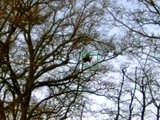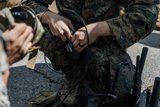Airbus tests stratospheric 4G/5G defence comms
Airbus has successfully tested stratospheric 4G/5G defence applications with a high-altitude balloon demonstration, the company announced on 25 September.
Supported by the French and Canadian space agencies, Airbus flew and tested the solution in Canada at all altitudes up to 21km above the Earth’s surface, using a stratospheric balloon to create a high-altitude airborne cell site. In its payload, the balloon carried an Airbus LTE AirNode, which provided a 30km-wide footprint of coverage for private and secure communications.
The Airbus team, equipped with two vehicles and two UAS, tracked the balloon over 200km, exchanging 4K video between the different assets – simulating an ISR mission with real-time transmission. The data was sent via a private network at speeds from 0.5 to 4Mbps, which is comparable to 4G/5G mobile communication.
The LTE AirNode is part of Airbus’ secure networked airborne military communications project, Network for the Sky (NFTS). An LTE AirNode allows opportunistic, secure communications between different aircraft as they fly within range of each other, where operations require permanent and powerful connectivity. It will deliver highly secure communications for airborne assets, ground or maritime-based operations for several weeks or months at a time, combining the persistence of a satellite with the flexibility of a UAV. This type of ad-hoc network can be adaptable to different users, including special forces and disaster relief scenarios.
With Airbus NFTS new generation of long-range communications, high-altitude platforms such as Airbus’ Zephyr will be able to create persistent, secured communication cells to relay information on a variety of different aircraft platforms including helicopters, tactical UAS and medium altitude long endurance UAS.
Airbus’ NFTS will integrate various technologies, such as satellite links with geostationary, medium and low Earth orbit constellations, tactical air-to-ground, ground-to-air and air-to-air links, voice links, 5G mobile communication cells and laser connections, into a single global secure network. Airbus aims to offer a full operational capability by 2020.
More from Digital Battlespace
-
![EID to unveil new vehicle communication system at DSEI]()
EID to unveil new vehicle communication system at DSEI
The Portuguese company’s naval communications system is in service across more than a dozen countries. It has turned to its home nation for support in developing a new vehicle based C2 system.
-
![Chess Dynamics successfully demonstrates Vision4ce AI-driven tracker]()
Chess Dynamics successfully demonstrates Vision4ce AI-driven tracker
The Vision4ce Deep Embedded Feature Tracking (DEFT) technology software is designed to process video and images by blending traditional computer vision with artificial intelligence (AI) algorithms to present actionable information from complex environments.
-
![Wave Relay devices cleared for security use on commercial systems in industry trend]()
Wave Relay devices cleared for security use on commercial systems in industry trend
Persistent Systems has been cleared by National Security Agency (NSA) to transmit sensitive data on commercial networks. The devices are added to the NSA’s Commercial Solutions for Classified (CSfC) component list which also includes other companies’ products providing the same security.
-
![UK teases cyber spending boost in Strategic Defence Review ahead of “imminent” release]()
UK teases cyber spending boost in Strategic Defence Review ahead of “imminent” release
The release of the UK’s Strategic Defence Review (SDR) has been long promised as mid-year. It is possible it could be as early as 2 June although the UK Ministry of Defence (MoD) continues to play its cards close to its chest.
-
![Intelsat emphasises SATCOM resilience for SOF in contested domains (video)]()
Intelsat emphasises SATCOM resilience for SOF in contested domains (video)
Intelsat outlines how its multi-orbit SATCOM architecture is enhancing connectivity and resilience for special operations forces operating in degraded and contested environments.
-
![US Space Force’s next-generation missile warning system moves forward with $500 million in new contracts]()
US Space Force’s next-generation missile warning system moves forward with $500 million in new contracts
Next-Generation Overhead Persistent Infrared (Next-Gen OPIR) satellites are intended to provide early warning of missile launches from any location worldwide and new ground stations will result in expanded coverage of critical missile warning.























